For most collectors, watch safes provide peace of mind rather than fulfill any real security necessity. Still, should the need arise a watch safe can more than pay for itself.
I’ve found that the higher end safes are almost as intricate, expensive, and, yes, beautiful in their own ways as the contents they protect.
If you follow my articles you know that I’m a working man’s watch kind of guy. For me the beauty of a timepiece lies in its functionality and utility. It does its job without fuss or unnecessary embellishment; form follows function.
That pretty much defines a watch safe. Some are mechanical marvels with multifunction control winders, various entryways, lighting systems, and even musical interfaces. The unimpeachable purpose they serve gives them an aura of enormous strength in an exquisite case.
Like the proverbial iron fist in a velvet glove.
Why buy a watch safe?
That is a good question. Some compare the price of a watch safe with the value of their collections, then decide to put that money into another watch instead.
On the other hand, the most dedicated collectors want the facility housing their watches to be as palatial as their lifestyles. For these individuals only the very best will do.
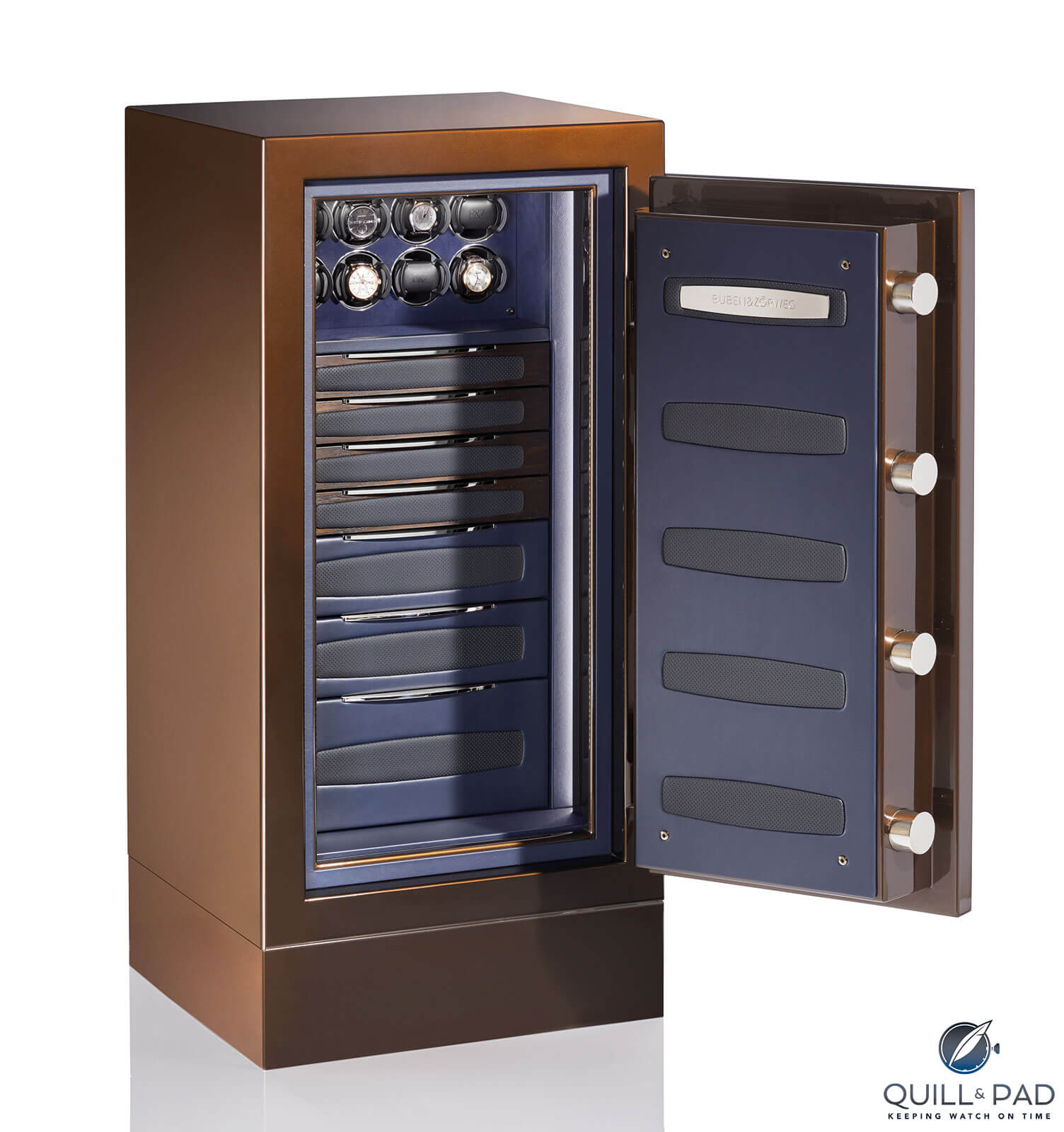
Buben & Zörweg Taurus with 8 winders
And so I spoke with three safe companies: BlumSafe, Stockinger, and Buben & Zörweg. They represent the low, middle, and top price ranges respectively. That is to say, prices for these gorgeous storage facilities run from $1,500 up to $2.75 million.
Stockinger CEO Matthias Fitzthum recognizes the move to customization for many participants in the luxury goods market – watch safes included. “Clients insist on complete control over the project exactly according to their vision and taste,” he said. “Safes are no longer hidden away. Customers want a beautiful piece of art that can be displayed. There is no limit to what goes into the design of a bespoke safe.”
And, as I have discovered, many want both to prominently display the safe and what’s inside, all while maintaining the same high level of security.
These are the first two reasons collectors invest in a watch safe: security of the collection and as a display piece, both for the safe itself and its contents.
But there is also a third reason. Watch safes say something about the individual whose collection is so valuable that it requires such a robust storage and exhibition facility. Before looking inside, even the most casual observer understands the level of resources in play.
The German firm Buben & Zörweg states the obvious and not-so-obvious reasons for housing a valuable collection in a dedicated safe. First comes security, and not only from burglars. The fact is that most collections are exposed far more frequently to those the owner trusts than professional crooks.
A watch safe acts as a deterrent against the casual opportunity theft. It keeps honest people honest.
That seems to be the strategy of BlumSafes, whose business model stresses convenience to the owner. These safes get hidden away inside a wall at chest level with something covering it like a painting or mirror. Since these safes’ door thickness is just five millimeters and the body thickness is just three, their main points of security are their stealthy hiding place and the time it will take a thief to find the safe and pry it open.
Essentially, such a security model provides a deterrent to those the owner trusts. The price point BlumSafes hits – $1500 to $2,000 – doesn’t compete with the cost of most luxury watches.
Since industry statistics find that the average burglary takes five to ten minutes, if the thieves use at least half that time to find the safe, it doesn’t leave much time to try opening it. To me, this is a very cost-effective solution.
Insurance underwriters would argue the point, though. Then again, it’s not their money buying the safe.
Buben & Zörweg raises the game by including temperature and humidity controls in their watch safes. These controls are said to create the optimum environment to ensure the perfect longevity of any fine timepiece.
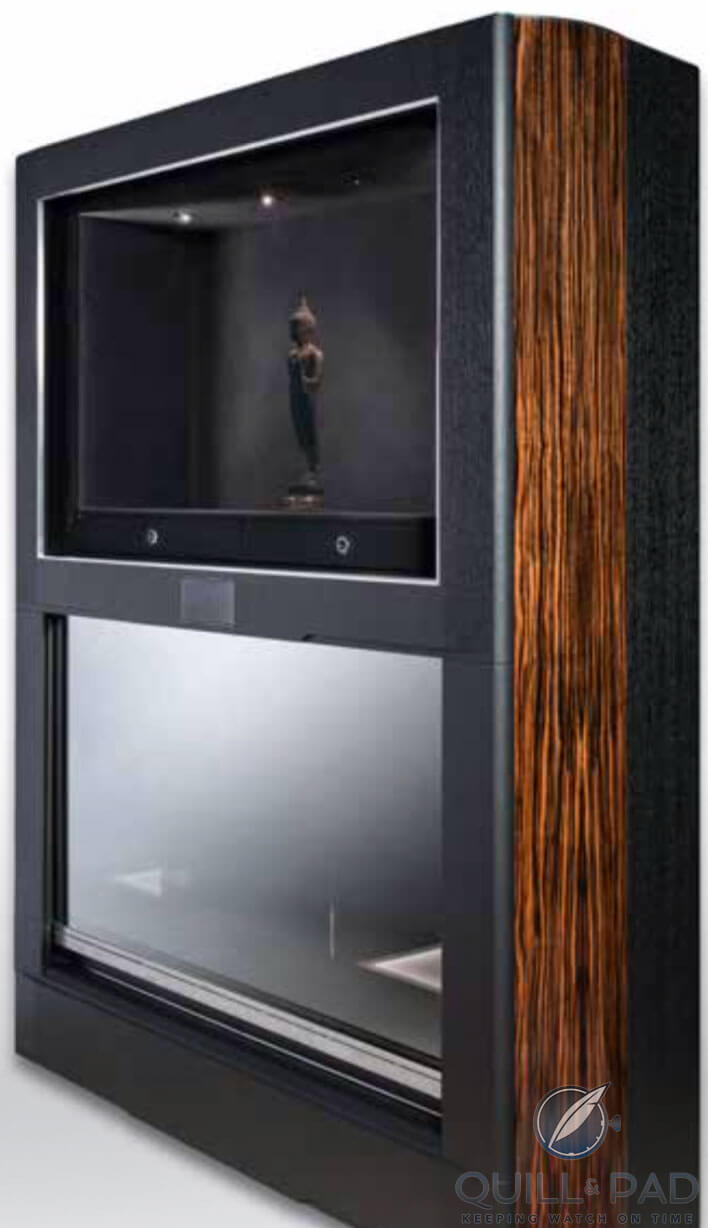
Buben & Zörweg Grande Private Museum
Buben & Zörweg provides the highest security for displaying the collection in its Grande Private Museum inbuilt units. These feature 22 millimeter-thick bulletproof glass that’s highly resistant to mechanical attacks when it’s closed.
When open for viewing the security glass quietly slides away, leaving behind an integrated laser curtain. You can look, but you’d better not touch else the alarm system that interfaces with the house or building systems will summon security or the police. That’s why Buben & Zörweg refers to its safes as masterpieces.
Last on my list of reasons to invest in a watch safe is insurance. One would think that the more secure the collection, the less risk of loss and therefore the lower your insurance premiums. That is logical.
However, consider the calculus of risk from the insurer’s point of view. Yes, the collection has a secure home. However, who is trusted with the access codes and/or combination? Whose fingerprint(s) are on the authorized access list for the digital print reader? Who have these trusted persons shared this information with? Right away, the safe’s security can be easily compromised.
And the most important question from the insurance company’s point of view: is the safe actually used? Surprisingly, many are so inconveniently located in the floor, hidden away in the basement, or in other places that they just aren’t used.
The best place they say to locate a watch or jewelry safe is in the dressing room. That’s also the first place a thief will look.
The good news about having a watch safe is that its presence may allow the insurance company to write a policy where it might not have done so without it. Full premiums, of course.
Who buys a watch safe?
The most obvious owners are those with extensive and valuable watch collections. But also jewelers buying and selling watches are likely to have a watch safe.
Amateur hobbyist watch traders may have a safe with winders rather than simply an unsecured watch winder cabinet sitting on the office credenza for all to see.
Museums are another purchaser of secure watch display facilities. Though these may be specially designed for a particular exhibit and most likely wouldn’t be appropriate for a home or office setting.
Being a substantially bespoke safe provider, Stockinger has developed an extensive list of private clients. For some the company provides entire armored security rooms populated by several watch winder display cabinets.
These safe rooms often serve several purposes at once by housing other collections as well.
Additionally, Stockinger safes increasingly appear aboard yachts. In speaking with CEO Fitzthum, I discovered one 300-foot superyacht with 18 Stockinger safes installed aboard.
Luxury hotels are adding high-end watch safes to their luxe rooms, too. The guest’s cell phone can program each winding cuff to the exact specifications the watch manufacturer suggests.
If as a guest you’re unsure which direction to program the hotel’s winder to and just how many daily rotations it requires, fear not. Buben & Zörweg (and others) provide a searchable database showing the suggested daily winding requirements for most watches on its website.
What’s really in a good watch safe?
For most top-end manufacturers such as Stockinger and Buben & Zörweg the number of winding cuffs depends on the owner’s desires. However, these companies’ stock pieces usually come with a predetermined number of independently programmable winders.
Watch safes are built today to house collections other just watches. Many contain temperature and humidity-controlled partitions to maintain the perfect environment for storing fine wines and cigars.
Jewelry is another natural to be housed with watches. Rare coin collections are often included within. Important papers such as passports, ownership documentation for cars, jet, and yachts, insurance policies, and stock certificates too.
Historic cameras, fine art photography, bars of gold, priceless manuscripts: they all seem to find a niche in the watch safe. For some, the watch safe soon becomes a Noah’s Ark of valuable bric-a-brac.
Separate safes are usually used to house rare (and other) firearms. These often contain display facilities, special lighting, and ammunition drawers.
Stockinger creates bespoke safes to house clients’ art pieces too. CEO Fitzthum says many of the safe rooms his company has created are like armored and access-controlled man caves. The owners keep everything from rare artwork to musical instruments and cars in there.
Often the interior design, fit, and finish is to the client’s exacting specifications, right down to the colors and hides used on the walls and display cabinets to match the colors of the vintage Ferrari.
“Our goal is not just to satisfy, we want to fascinate our clients,” says Fitzthum.
Options for your watch safe
The best way to determine what you need in your watch safe is to start from the inside, then work your way out.
Interior
What do you want your interior to look like? Most top-end safe manufacturers offer a choice of materials like velvet, suede, napa leather, and Alcantara. If you’re considering hides, Stockinger, being a custom house, will give you pretty much whatever you want.
The company marshals more than 30 experts in their fields in producing a single safe: industrial and graphic designers, metal workers, varnishers, saddlers, and sewers.
The quality of Buben & Zörweg’s interiors seems to be right up there as well. Generally the interior colors used are dark and discrete to better highlight what’s on display.
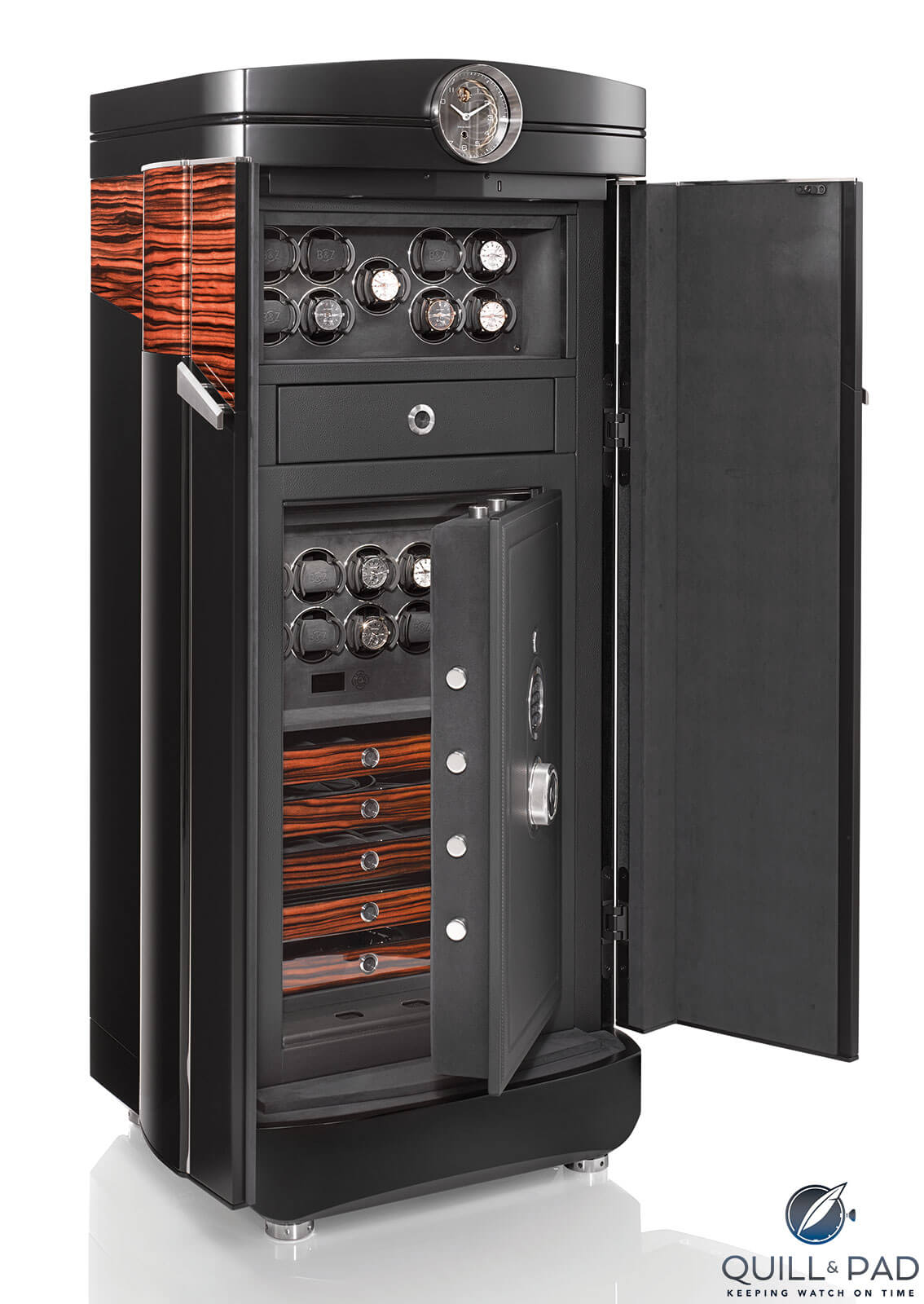
Buben & Zörweg Galaxy Deluxe
To store watches, determine how many rotating winders you will need for your collection. The experts suggest adding a few more than you need right now to allow the collection to grow.
Fair warning: it’s just irksome seeing a vacant winder. There becomes an urge to fill it with something equally as extraordinary as the safe housing it.
If you’re picky about the winders, choose a manufacturer that uses one you trust. Stockinger uses winders made by Erwin Sattler in Munich. These are high-precision watch winders, each with its own motor that can be independently programmed for direction and daily turns.
All drums return to the 12 o’clock position after each winding interval to make the display appear uniform.
Buben & Zörweg calls its watch winders Time Movers, and control over them seems a little more comprehensive.
Their short winding cycles are followed by a longer rest phase. Additionally, each winder has a sleep phase allowing the watch to wind down over a 12-hour period to release tension from the winding spring. Over a 24-hour cycle the watch should be at approximately 60 percent capacity.
Determine the size of certain watches in your collection to be sure they will fit on the winders provided. Stockinger makes custom watch cushions sized to the owner’s wrist that fit specific watches in the collection.
If you’re including other collections such as writing instruments, jewelry, rings, necklaces, and cufflinks in the safe, you might want to plan for how they’ll be stored.
Most commonly used are drawers. Some owners – particularly those in India – will not want standard cow skin used for the leather handles in the drawers. Be sure the manufacturer offers an alternative such as lambskin.
Other interior features
Buben & Zörweg includes climate-controlled spaces for the watches.
Safe interiors can become quite complicated with a variety of items included. Wine and cigar storage each require their own separate climate-controlled spaces, for example.
Firearms are another issue entirely. Their size alone usually requires a dedicated storage space. The good news is that they aren’t so particular about ambient temperature and humidity as watches, wines, and cigars.
Interior lighting is another feature to consider. You want your valued treasures revealed in sparkling light when the doors open, specially if your watch safe serves double duty as a display case.
Don’t forget the music. Buben & Zörweg provides a Bluetooth-enabled music system that activates when the doors open.
Exterior
Many safes are beautiful display pieces unto themselves. Others are meant to be hidden away from curious eyes. The first step in determining the exterior plan is to decide where the safe resides.
If it’s going to be part of the room decor, then choose the size and shape. These can be anything you wish. In the case of Stockinger, the opening mechanism is hidden from view, revealed with a tap on the company logo: out slide the access controls.
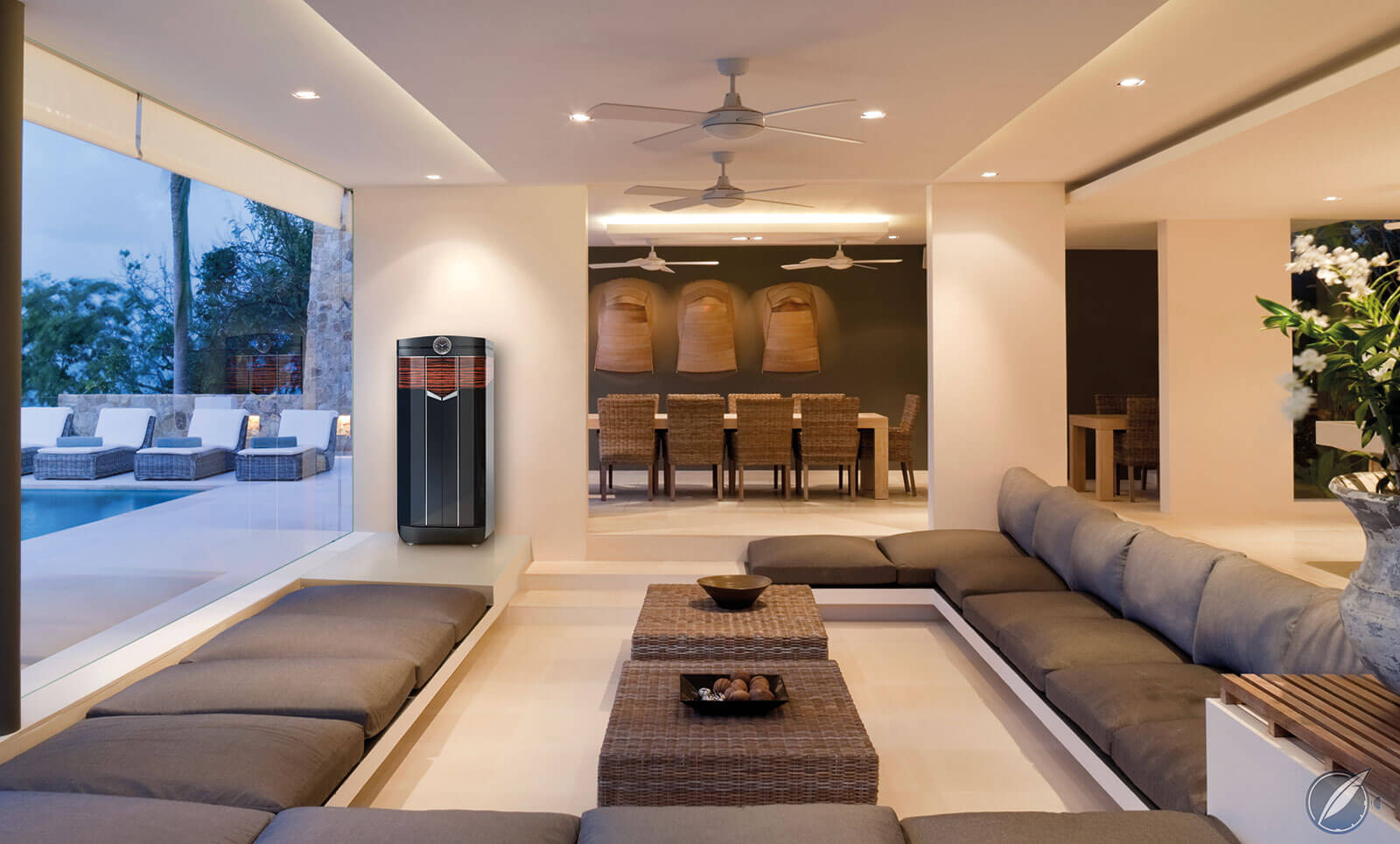
Buben & Zörweg Galaxy Deluxe as an art object
Stockinger paint finishes are among the finest anywhere. The company generates its incomparable color depth using up to 18 layers of varnish – more than for a Steinway grand piano.
Stockinger is known as the Rolls-Royce of safes; its artisans can duplicate any color you choose. They’re now covering their safes in fine hides as well.
Buben & Zörweg has been using fine hides for some time, which are elegantly stitched and feature ornamental seams. We’re not talking just the visible side here. But the whole safe is dressed in leather to better accentuate its design features.
Both companies will finish the handles in anything you wish: platinum, yellow, white, or pink gold, titanium, brass. Anything.
Buben & Zörweg also finishes its exteriors in exquisite wood veneers, often high-gloss macassar or ebony grigio. Truly, they deserve the moniker masterpiece that the company gives them.
If your safe is going to be hidden from view, then the exterior really doesn’t matter much. However, its placement does. Select a convenient place, close to where you’ll be using its contents.
Also, if you’re putting it in a wall, you might choose a convenient height so you can more easily see what’s inside.
How safe should a safe be?
Stockinger makes the claim that no one has ever opened one of its safes by force. The company follows up this claim saying, “And we will do anything to keep it that way.”
Security levels of safes is a subject unto its own. Fascinating, but probably of little use for most of us.
Here’s the short version: the German security insurance company association, Verband Deutscher Sachversicherer, identifies classifications for safes as VDS III, IV, or V.
It will insure a safe’s contents with a VDS III classification for up to €500,000. It goes up from there to the VDS IV and V classifications. By the way, a safe carrying a VDS V rating is impermeable to an attack by diamond tools. Insurance companies will insure its contents for up to €20 million.
In the United States, safe performance ratings are the yard stick used by the major insurance companies called upon to carry the risk of inventories held by jewelers and coin dealers. These are based on wall thickness of the steel or composite used.
United Laboratories in the U.S. is the authority in performance testing. Here are the current wall thicknesses used by insurance companies to insure inventory at various value levels in a retail jewelry store are:
TL-15 Plate Steel – $150,000
TL-15 Composite – $250,000
TL-30 Plate Steel – $250, 000
TL-30 Composite – $350,000
TL-30×6 – $750,000
TRTL-30×6 – $1,000,000
Then there’s United Lab’s UL TL15 Stealth rating. That’s commercial-level security for higher value collections. Such a rating is issued for safes that are likely to be targeted by professional safecrackers. So in addition to a brute force attack on its walls, the opening mechanism would also be considered in issuing the rating.
When designing the required security for their safes, both Stockinger and Buben & Zörweg conduct tests using attacks by munitions, explosives, torch cutters, all kinds of striking tools such as hammers and chisels, and a variety of power tools with an array of drill bits.
Let’s talk locks
Many consider the lock to be the safe’s most vulnerable point of entry. After all, if an intruder knows the digital key code or combination, he can gain entry no matter what the safe is made of.
Industry convention for locking configurations seem to employ a seven-digit keypad and emergency combination lock should you forget the key sequence.
Buben & Zörweg’s electronic rotary knob activates a motor that operates a gear system to release the locking bolt(s) securing the door. There are two of each component in the locking mechanism, allowing it to hold fast should any one component fail.
The life span of the lock is rated at 15 million hours. By the way, the entry controls on the Buben & Zörweg safe are right there in plain sight.
Stockinger is a little more subtle. A gentle press of the logo button slides the key pad and display out for easy access. Enter the code, an interior bolt retracts; turn the handle and you’re in.
For Stockinger safes, even though the digital keypad is hidden the large opening handle sits smack in the middle of the door. For either manufacturer, there’s no mistaking that it’s a safe. For some, that’s the point. Come get me, give it your best shot.
Should the owner forget the access code for a Stockinger safe, he or she must go to the company for assistance in opening. Matthias Fitzthum says this happens maybe once or twice a year: usually when a divorce occurs and the aggrieved party deliberately changes the code.
Buben & Zörweg generally provides two ways to open the safe: a seven-digit electronic locking system and a redundant locking system with mechanical key.
On request for those not wishing to bother remembering combinations or key sequences, Buben & Zörweg will equip a safe with biometric fingerprint or some other opening mechanism such as a palm reader, retina scanner, or even a scanner that reads the unique blood vein pattern in your hand.
Is a free-standing safe . . . safe?
Neither Stockinger nor Buben & Zörweg seemed worried about providing free-standing safes. After all they’re very heavy, usually on the order of 850 pounds or more. Not easily carted away.
And beyond that they’re connected to the house alarm with both electrical current and with a battery. Cut the cable and the alarm goes off. There are also electronic sensors that activate if the safe moves more than one mm, which also trips the alarm.
I discovered that bolting your safe into the floor is old school. Modern attack tools used by skilled thieves can quickly defeat even the most hardened bolt or cement configuration. And forget about the floor construction – that’s the weakest point of the entire system.
Pricing
As with any bespoke piece, safes can run through a wide range of pricing. It depends on all the variables discussed so far. Still, let’s get an idea of what a good watch safe may run.
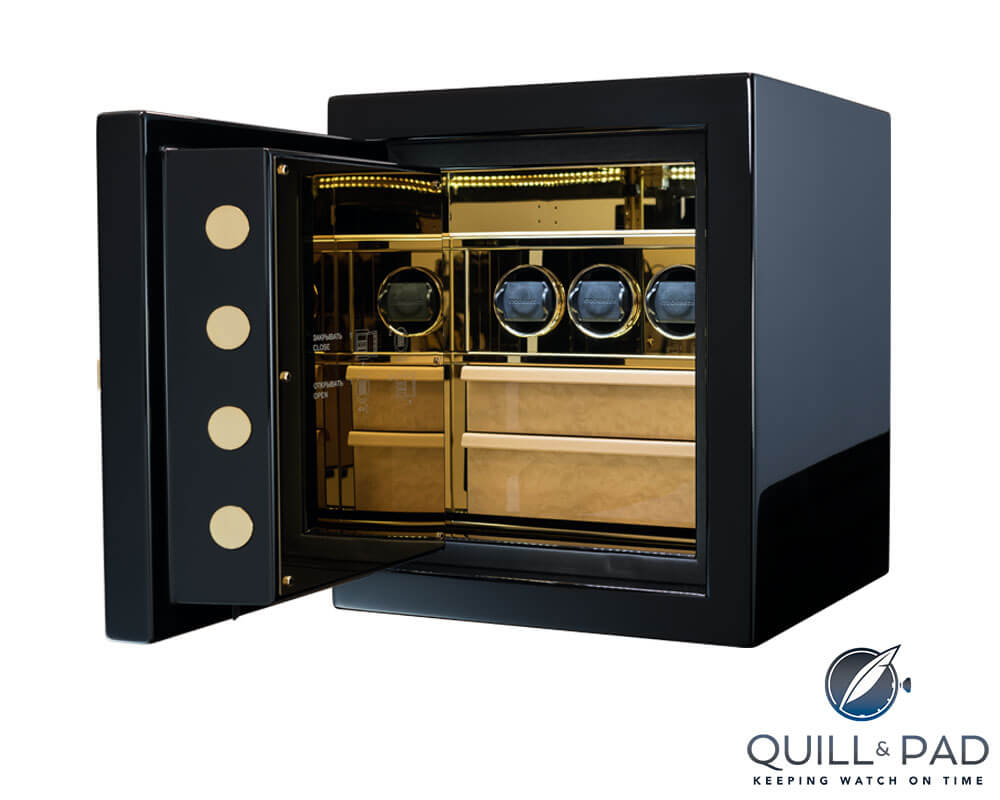
Stockinger Hotel Cube 3V
Stockinger prices begin at €2,870 for the smallest hotel safe without watch winders, quickly escalating from there. The Hotel Cube with three watch winders runs for €22,800.

Stockinger Chimera 10V
Moving up from there, the Stockinger Chimera with 12 watch winders costs out at €78,000.
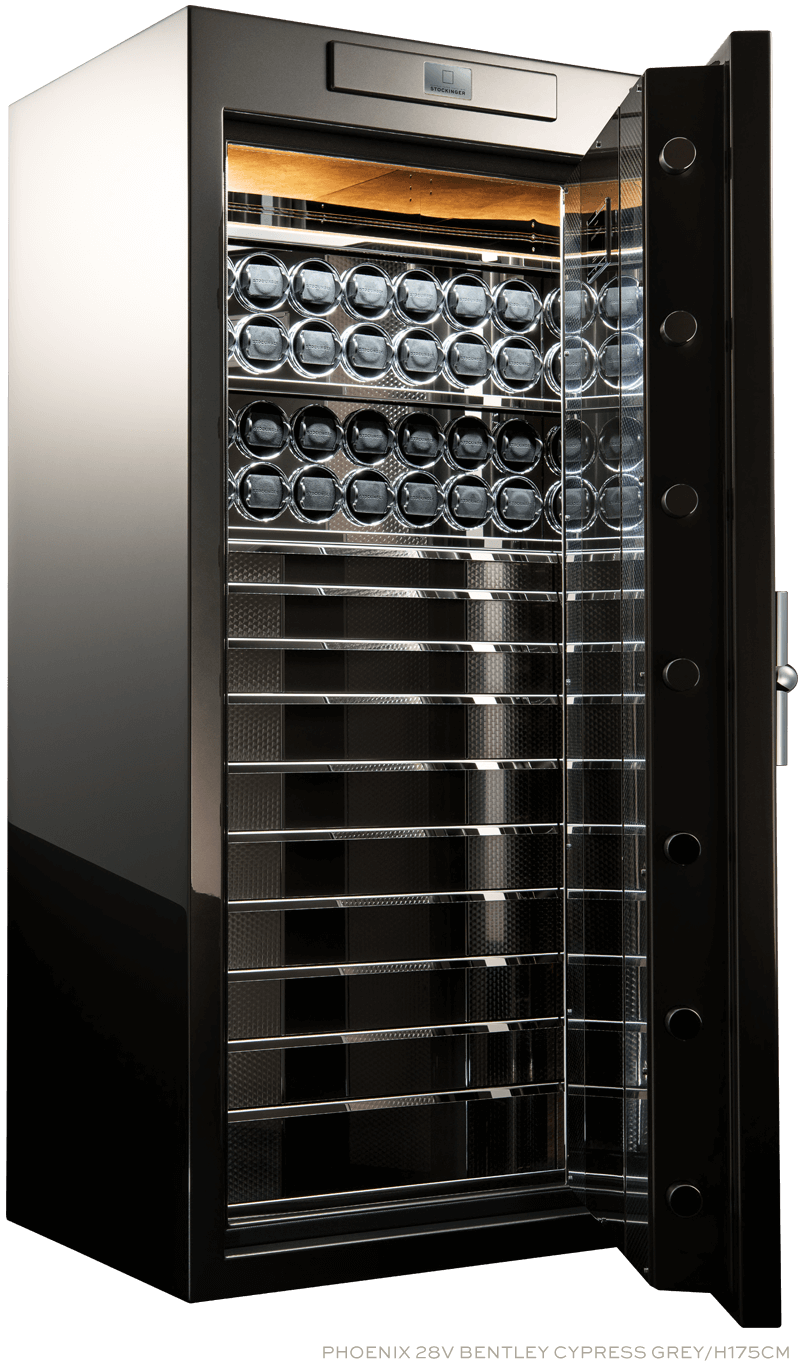
Stockinger Phoenix 28V
Finally, the Stockinger Phoenix with 28 watch winders comes in at €116,800.
For very large watch collections, Stockinger can provide its Phoenix safe with 70 winders for approximately €250,000.
The largest watch safe Fitzthum told me about was actually a safe room containing 800 watch winders. Its cost was on the order of €2.75 million, but I image there were facilities to store other treasures than just watches.
Watch safes are luxurious
. . . as are the collections they house. And they are pricey. There’s a way to gauge how much you should spend protecting your watch collection: compute the expected value of the loss. Here’s how to do it:
- How much is your watch collection worth?
- What is the probability of it being stolen?
- Multiply the two and up pops the expected value of the loss. That is also the theoretical amount you should spend protecting it.
So if a watch collection is worth, say, $500,000 and its likelihood of being stolen is five percent, then the expected value of the loss is $25,000. Per this calculation that’s what you should spend on a watch safe.
However, as we saw earlier, that will get you a very small VDS-III rated box without a single winder. Not nearly large enough to contain a $500,000 watch collection.
Safes are a conundrum. In the end, I believe making a decision involves protecting not just the monetary replacement value of the collection but the intrinsic value of your most prized possessions.
For more information, please visit www.buben-zorweg.com, www.blumsafe.com, and/or www.stockinger.com.
You may also enjoy:
The Tool Watch Revolution: Utilitarian Goes Upmarket
Watch Customization: Give People The Watch They Want
Tutima M2 Pioneer In Bora Bora, Tahiti: An Aqua-Terrestrial Review (Somebody Had To Do It!)
Leave a Reply
Want to join the discussion?Feel free to contribute!





















































Fascinating! Couldn’t stop reading.